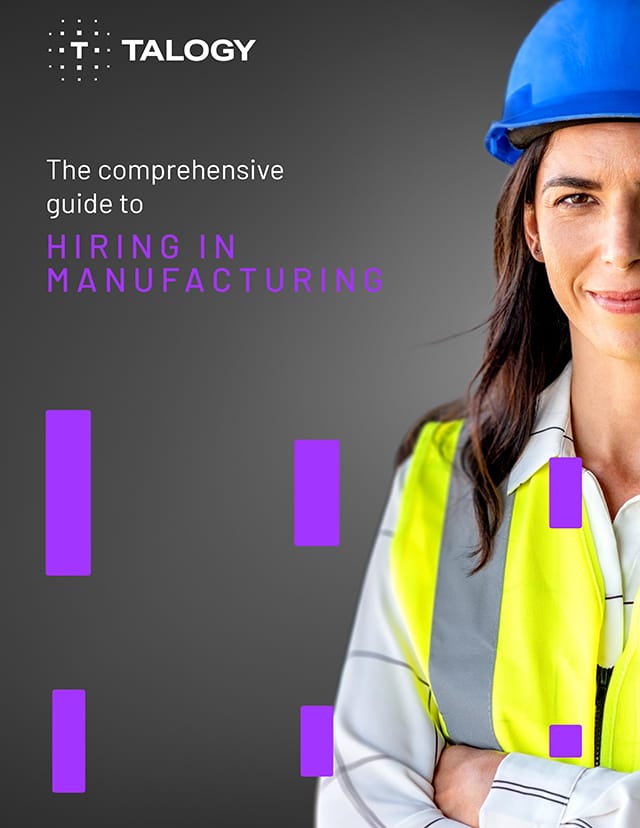Written by Jaclyn Menendez, Ph.D., Project Consultant
We’re all seeing it: “Help Wanted” signs adorning businesses in every direction you look. And many of us are feeling it. Even if you don’t work directly in the manufacturing world, chances are you’ve experienced at least one shortage (ahem, looking at you, toilet paper) over the past year. On one hand, the demand for goods and services couldn’t be higher. On the other hand, the gaps in manpower required to meet the needs are huge. And stuck right in the middle is nearly every manufacturing company (as well as many other industries) trying to gain their footing and get some traction in the labor market.6 Tips for How to Hire in Manufacturing During a Labor Shortage
In recent months, Talogy has seen unprecedented unity from nearly all of its manufacturing clients regarding the US labor shortage. Regardless of the specific business or company size, manufacturing as a whole is struggling to fill both skilled and unskilled roles. Below are some tips to help you boost your applicant pool when recruiting manufacturing employees and some trade-offs to consider along the way.
Develop a marketing strategy
Application incentives and sign-on bonuses are becoming more common, though be aware that these measures do not necessarily lead to high quality or long-term hires. Also consider one-day job fairs where applicants can complete the entire selection process from start to finish and receive an offer same day. This is beneficial to the candidate as well as the company since it expedites the available start dates.
Have targeted recruiting efforts
Realistic job previews (RJP) and testimonials are helpful for showing the “real life” benefits of these roles. These also humanize the work itself and the employees performing the work. Partnerships with local colleges, trade schools, and even middle schools have shown to increase applicant pools. Get your company’s name in front of these students early and often.
Employ an efficient screening process
At the start of your selection process, the importance of streamlining your basic screening steps and communicating timelines cannot be overstated. When candidates do not know what to expect, they continue to apply elsewhere in the meantime. Being up front on estimated timing for next steps and communicating any changes goes a long way with what will hopefully be future employees.
Keep candidate convenience in mind
The assessment stage of your selection process must be accessible via cellphone or some other convenient alternative. A feasible option is offering to administer the assessment on site along with all other in-person requirements for the entire process. This is particularly attractive if your candidate is already employed; do not ask them to take multiple days off from their current job to apply for yours.
*****
Bonus tip!
You may be tempted to shorten the steps in your assessment process in hopes that it will lead to more candidates getting through the early steps. While this may seem great for filling job vacancies quickly, a common trade-off is a spike in failures during the interview stage which can strain your HR department.
If you choose to remove selection steps altogether, the most commonly associated issues are an increase in safety incidents, increased early turnover, and negative impacts to company culture.
*****
Invest in your people
Upon hiring, onboarding and team building are crucial to keeping new hires long term. The more committed your new hires feel to the company and its mission, the longer they will stay. One simple way to engage new hires is to promote training and development. Another is to pair new hires with an incumbent mentor who can serve as an additional resource. Let’s not overlook providing company-branded swag. This can help make your new hire feel like part of the team. It might seem like something small, but celebrating their first day with a gift will make them feel welcome. And really, who doesn’t like free giveaways?
Feedback is your friend, so solicit it
After hiring, recruit your team leaders to provide insight on any questions they’re getting or issues they’re seeing with their new team members. Also gather frequent informal feedback from new hires regarding their satisfaction and perceptions of the role. Engage them as your new marketing assets on how to best draw in more applicants. Above all else, remember that even in high-volume hiring, everyone wants to feel like they matter.
While times are tough now, this shortage will not last forever. The pandemic will gradually have less of an impact on many aspects of our lives and people will be comfortable resorting back to their old routines and work habits.




